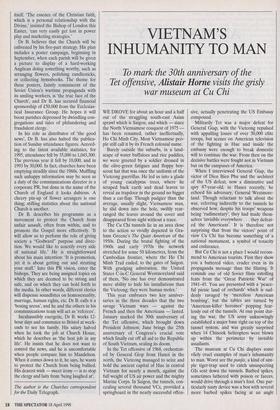VIETNAM'S INHUMANITY TO MAN
To mark the 30th anniversary of the war museum at Cu Chi
WE DROVE for about an hour and a half out of the straggling south-east Asian sprawl which is Saigon, and which — since the North Vietnamese conquest of 1975 has been renamed, rather ineffectually, Ho Chi Minh City. Most Vietnamese peo- ple still call it by its French colonial name.
Barely outside the suburbs, in a land- scape of water buffaloes and rice paddies, we were greeted by a soldier dressed in the olive-green fatigues and floppy boy- scout hat that was once the uniform of the Vietcong guerrillas. He led us into a glade of young eucalyptus trees, where he scraped back earth and dead leaves to reveal an trapdoor in the ground no bigger than a cat-flap. Though pudgier than the average, usually slight, Vietnamese man, he slid down into the hole, swiftly rear- ranged the leaves around the cover and disappeared from sight without a trace.
The Cu Chi tunnels lie in an area close to the action so vividly depicted in Gra- ham Greene's The Quiet American of the 1950s. During the brutal fighting of the 1960s and early 1970s the network stretched for some 50 kilometres, from the Cambodian frontier, where the Ho Chi Minh Trail ended, to the gates of Saigon. With grudging admiration, the United States C-in-C General Westmoreland said of them, `No one has ever demonstrated more ability to hide his installations than the Vietcong; they were human moles.'
This year embraces two key anniver- saries in the three decades that the two savage Vietnam wars — against the French and then the Americans — lasted. January marked the 30th anniversary of the Tet offensive, which brought down President Johnson; June brings the 25th anniversary of Congress's crucial vote which finally cut off all aid to the Republic of South Vietnam, sealing its doom.
In the Tet offensive of 1968, orchestrat- ed by General Giap from Hanoi in the north, the Vietcong managed to seize and hold the ancient capital of Hue in central Vietnam for nearly a month, against the full weight of US air power and the mighty Marine Corps. In Saigon, the tunnels, con- cealing several thousand VCs, provided a springboard in the nearly successful offen- sive, actually penetrating the US Embassy compound.
Militarily Tet was a major defeat for General Giap, with the Vietcong repulsed with appalling losses of over 30,000 elite troops, but scenes on American television of the fighting in Hue and inside the embassy were enough to break domestic will to continue the war. From then on the decisive battles were fought not in Vietnam but on the campuses of America.
When I interviewed General Giap, the victor of Dien Bien Phu and the architect of the US defeat, now a diminutive and spry 87-year-old, in Hanoi recently, he echoed his adversary, General Westmore- land. Though reluctant to talk about the war, referring indirectly to the tunnels he observed how, despite his troops' weapons being 'rudimentary', they had made them- selves 'invisible everywhere . they defeat- ed the Americans'. It is therefore not surprising that from the victors' point of view Cu Chi has become something of a national monument, a symbol of tenacity and endurance.
But Cu Chi is not a place I would recom- mend to American tourists. First they show you a battered video, cruder even in its propaganda message than the filming. It reminds one of old Soviet films extolling feats from the 'Great Patriotic War' of 1941-45. You are presented with a 'peace- ful picnic land of orchards' which is sud- denly ravaged by 'merciless American bombing', but the tables are turned by `American-killer heroines' popping fear- lessly out of the tunnels. At one point dur- ing the war, the US army unknowingly established a major base right on top of the tunnel system, and was greatly surprised when 14 Chinook helicopters were blown up within the perimeter by invisible assailants.
The museum at Cu Chi displays some vilely cruel examples of man's inhumanity to man. Worst are the punjis, a kind of sim- ple tiger-trap used to catch unsuspecting GIs sent down the tunnels. Barbed spikes, sometimes lathered with poison or faeces, would drive through a man's foot. One par- ticularly nasty device was a box with several more barbed spikes facing at an angle downwards, so it would be impossible to remove the injured leg. As our young guide explained with a heartless laugh, 'So you have to take the whole thing with you on the hospital helicopter!' Eleven per cent of all America's 303,678 casualties during the war, and 17 per cent of all fatal- ities, were caused by such booby-traps. In the museum shop you can buy US bomb splinters, or rounds of an AK-47 to fire at an 'enemy target', or US army dog- tags. A stretch of tunnels has been widened to accommodate paunchy West- ern visitors, but, even so, five minutes down there in the fetid heat and darkness is more than enough. During the war, the tunnels sometimes housed up to three Vietcong battalions for weeks at a time. Even precious water buffaloes were sta- bled below ground. Hospitals operated on the crudest of resources, often without anaesthetics and with only honey as an antiseptic. Few of the seriously wounded survived. Snakes, rats, mosquitoes and Chiggers infested the tunnels.
To combat the enemy, the US deployed dogs, flame-throwers and poison gas (the Vietcong countered the gas by construct- ing lavatory-style U-bends in the tunnels). Some scientist in the States even toyed with the idea of 'programming' bedbugs which, drawn to flesh, would betray the enemy's presence. Because of the casual- ties to the dogs, the dog-handlers revolted. In short, nothing succeeded. Eventually, special 'tunnel rat' squads, suicidally brave men, were recruited by the US army to fight below ground — with attractive bonuses. Hispanics, because of their small stature, were particularly favoured, and at least one Cuban illegal immigrant won his green card that way. Many died or went mad. Next, 'Rome ploughs', 60-ton bull- dozers that could churn up soil six feet deep, were introduced. Finally, as the ulti- mate weapon, the area was cleared and the B-52s with monster blockbusters were brought in. That succeeded.
The Vietcong were on the verge of defeat, but by this time America had had enough. In June 1973, Congress withdrew all aid, abandoning their South Viet- namese allies to a grim fate. Two years later Saigon fell.
The women in our group (and the men, too) were profoundly affected by the hor- ror of the tunnels. One remarked, 'How could you possibly expect 19-year-old boys from the corn belt, who probably didn't know where Vietnam was, let alone what the war was about, to fight this kind of a war?' It was a thought compounded by the recent showing on television of a hideously unpleasant and distressing American film, Casualties of War (1989), which centred around a My Lai-style incident and depict- ed demoralised young draftees totally out of their depth, and out of control. The Vietcong at least had the supreme advantage of fighting on their own soil; something which gave the Russians their edge when defending Mother Russia against the Germans in 1941-45, but in turn rendered them hopeless when fighting the Afghans or Chechens on their home ground. More than anything I have read, the tunnels of Cu Chi made me question how any Western troops could possibly fight 'this kind of a war'. I only hope they never have to do so again.
As far as the Vietnamese are concerned, their figures claim a loss of 3.5 million men out of a present population of somewhere over 75 million. In the streets of Hanoi there seem to be few men of middle age. Nor are there many amputees of that gen- eration; most of the seriously wounded died. The limbless are mainly the young, who have been mutilated by the mines still scattered across the country.
The proverbial man from Mars might be entitled to wonder, after so famous a victo- ry which side won? The Coca-Cola sales- men are back in force. Vietnam is full of American yuppies, who find little residue of resentment in a country determined to pull itself up from the ruins and errors of the past and espouse shamelessly whatever benefits the almighty US dollar can bring.
Alistair Horne's latest book is How Far from Austerlitz? Napoleon 1805-1815.



























































 Previous page
Previous page